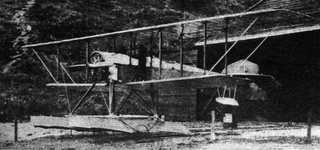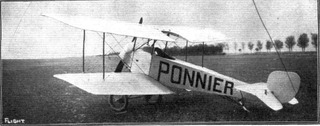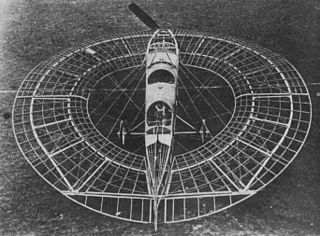| Borel hydro-monoplane | |
|---|---|
 | |
| Role | Seaplane |
| National origin | France |
| Manufacturer | Etablissements Borel |
| First flight | 1912 |
| Developed from | Morane-Borel monoplane |
The Borel Hydro-monoplane (also called Bo.8 [1] ) was a French seaplane produced in 1912.
| Borel hydro-monoplane | |
|---|---|
 | |
| Role | Seaplane |
| National origin | France |
| Manufacturer | Etablissements Borel |
| First flight | 1912 |
| Developed from | Morane-Borel monoplane |
The Borel Hydro-monoplane (also called Bo.8 [1] ) was a French seaplane produced in 1912.
The Borel hydro-monoplane, which was developed from the 1911 Morane-Borel monoplane, was a tractor monoplane powered by an 80 hp Gnome Lambda rotary engine. The rectangular section fuselage tapered to a vertical knife-edge at the rear: at the front the longerons on each side were curved inwards, meeting at the front engine bearer. A curved aluminium cowling covered the top of the engine, and the sides of the fuselage were covered with aluminium as far aft as the rear of the cockpit. The two seats were arranged in tandem, with the pilot sitting in front. Dual controls were fitted. Tail surfaces consisted of a narrow-chord fixed horizontal surface with a much broader elevator with horn balances hinged to the trailing edge and a balanced rudder which extended below the sternpost and carried a small float. The main undercarriage consisted of a pair of unstepped flat-bottomed floats. Lateral control was by wing warping. [2]
An example was entered in the 1913 Schneider Trophy competition, but crashed during the elimination trials. [3]
Another example, flown by George Chemet, was the winner of the 1913 Paris-Deauville race. [4]
Data from Flight, 26 July 1913, p. 814 [5]
General characteristics

The Sopwith Tabloid and Sopwith Schneider (floatplane) were British biplanes, originally designed as sports aircraft and later adapted for military use. They were among the first successful types to be built by the Sopwith Aviation Company. The "Tabloid", so named because of its small size, caused a sensation when it made its first public appearance.

The Bristol Scout was a single-seat rotary-engined biplane originally designed as a racing aircraft. Like similar fast, light aircraft of the period it was used by the RNAS and the RFC as a "scout", or fast reconnaissance type. It was one of the first single-seaters to be used as a fighter aircraft, although it was not possible to fit it with an effective forward-firing armament until the first British-designed gun synchronizers became available later in 1916, by which time the Scout was obsolescent. Single-seat fighters continued to be called "scouts" in British usage into the early 1920s.
Fabre Hydravion is the name used in English-language sources for an originally unnamed experimental floatplane designed by Henri Fabre. The aircraft is notable as the first to take off from water under its own power.

The Voisin Canard was an aircraft developed by Voisin brothers during 1910 and first flown early in 1911. It was named the Canard because of the resemblance of its forward fuselage to that of a duck's long neck while in flight. It was originally flown as a landplane: with the addition of floats it became one of the first seaplanes used by the French Navy.

The Bristol T.B.8, or Bristol-Coanda T.B.8 was an early British biplane built by the Bristol Aeroplane Company and designed by the Romanian Henri Coandă. Fifty four Bristol T.B.8s were built, being mainly used as a trainer. A small number of Bristol T.B.8s were briefly used as bombers at the start of the World War I by the Royal Naval Air Service.

The Morane-Borel monoplane was an early French single-engine, single-seat aircraft. It was flown in several European air races.

The Bristol Gordon England biplanes were a series of early British military biplane aircraft designed by Eric Gordon England for the Bristol Aeroplane Company that first flew in 1912. Designed for easy ground transport, the aircraft could be quickly disassembled.

The Blackburn Type L was a single-engine, two-seat biplane built for the 1914 Daily Mail Circuit of Britain seaplane race of 1914.

The Blackburn Type I was a single-engine civil two-seat monoplane built in the United Kingdom in 1913. Three were produced and used for flying demonstrations and training including seaplane pilotage.
The Hydro no.120 was a Romanian-designed two-seat, single-engine biplane configured as a single-float seaplane. Built by Bristol in 1913, it was lost on its first flight.

The Short S.41 was a British single-engined biplane built for the Royal Navy in 1912. Capable of being operated either on wheels or floats, it was successful enough for a further two similar aircraft to be built, with the type remaining in use until the early years of the First World War.

The Short S.27 and its derivative, the Short Improved S.27, were a series of early British aircraft built by Short Brothers. They were used by the Admiralty and Naval Wing of the Royal Flying Corps for training the Royal Navy's first pilots as well as for early naval aviation experiments. An Improved S.27 was used by C.R. Samson to make the first successful take-off from a moving ship on 9 May 1912.

The ASL Viking was a single-engined two seater biplane aircraft designed and built by Horatio Barber's Aeronautical Syndicate Ltd. at Hendon. It was first flown in January 1912.

The Short S.36 was a British two-seat tractor biplane, built by Short Brothers for Francis McClean in 1911. It was later developed into the Short S.41 and Short S.45, which were the first of a long series of similar aircraft built for the RNAS and RFC.

The Gabardini monoplane was a successful early monoplane constructed in Italy which made several notable flights, often carrying passengers, just before World War I. During the war, a number of lower-powered Gabardini monoplanes served as a training aircraft for the military.

The Ponnier L.1 was an early French biplane single seat scout, built just before World War I. It did not reach production.

The Ponnier D.III was a French monoplane racing aircraft, designed to compete in the 1913 Gordon Bennett Trophy race. It finished a close second.
The Caudron Type H was a collective name for three different Caudron designs of 1912-3. One of these was an amphibious three seat biplane built for the French military. Two were completed, one appearing at the Paris Aero Salon in November 1912.

The Caudron Type L was a two-seat French pusher configuration amphibious biplane, flown around 1913 and intended for naval use.

During the pioneer years before the First World War, Cedric Lee and G. Tilghman Richards in the UK built and flew a series of aircraft having a novel flat ring-shaped or annular wing. They built both biplane and monoplane types, and in 1913 their first monoplane proved to be an early example of a statically stable aircraft.
| Wikimedia Commons has media related to Morane-Borel monoplane . |